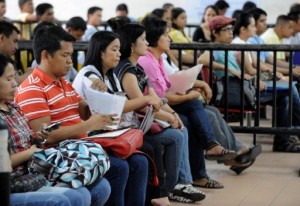
Many companies in the country are planning to hire more workers in the coming quarter in anticipation of a heightened demand for their goods and services, results of a survey by the Bangko Sentral ng Pilipinas showed. AFP PHOTO/JAY DIRECTO
Many companies in the country are planning to hire more workers in the coming quarter in anticipation of a heightened demand for their goods and services, results of a survey by the Bangko Sentral ng Pilipinas showed.
The BSP said the employment outlook index, which indicated the desire of the business sector to augment their workforce, improved to +24.1 percent in the second quarter of this year from +23 percent in the previous three-month period and +22.1 percent in the second quarter of 2012.
The latest reading was the second-highest on record following the +27.4 percent recorded in the third quarter of 2012.
The index is computed as the percentage of respondent firms that disclosed plans to hire more workers less the percentage of those that did not indicate such plans.
According to BSP Deputy Governor Diwa Guinigundo, the higher employment outlook index reflected expectations among corporate entities that business activity would pick up in the coming months, consistent with the economy’s expansion.
He said companies intended to hire more people to meet the likely jump in demand.
“In line with the favorable business sentiment for the next quarter, firms in the industry sector continued to have a favorable outlook on the economy,” the BSP said in a report on the results of the survey, which was conducted across the country from April 1 to May 10. There were 1,554 firms covered by the survey, which had a response rate of 83 percent.
Data from the survey further showed that some of the firms that intended to hire additional workers would do so to complement their expansion plans.
Of the survey respondents, the BSP said 28.7 percent reported plans to expand. The BSP said the figure remained significant, although lower than the 29.6 percent recorded in the first quarter and the 29.1 percent registered in the second quarter of 2012.
The intention of firms to hire more workers and expand operations came with the consensus that the Philippine economy would continue to post a healthy pace of growth this year on account of rising consumer demand and investments.
The economy grew by 6.6 percent last year, one of the fastest growth rates in Asia. This year, the government expects economic growth of between 6 and 7 percent.
The Philippines recently got investment-grade ratings from Fitch Ratings and Standard & Poor’s. This is expected to help the country attract much-needed foreign investments. The Philippines continues to lag behind most of its neighbors in terms of foreign direct investments. An increase in FDIs, which amounted to about $2 billion last year, would mean an increase in demand for supply of raw materials, intermediate goods and services that can provide opportunities to local firms.